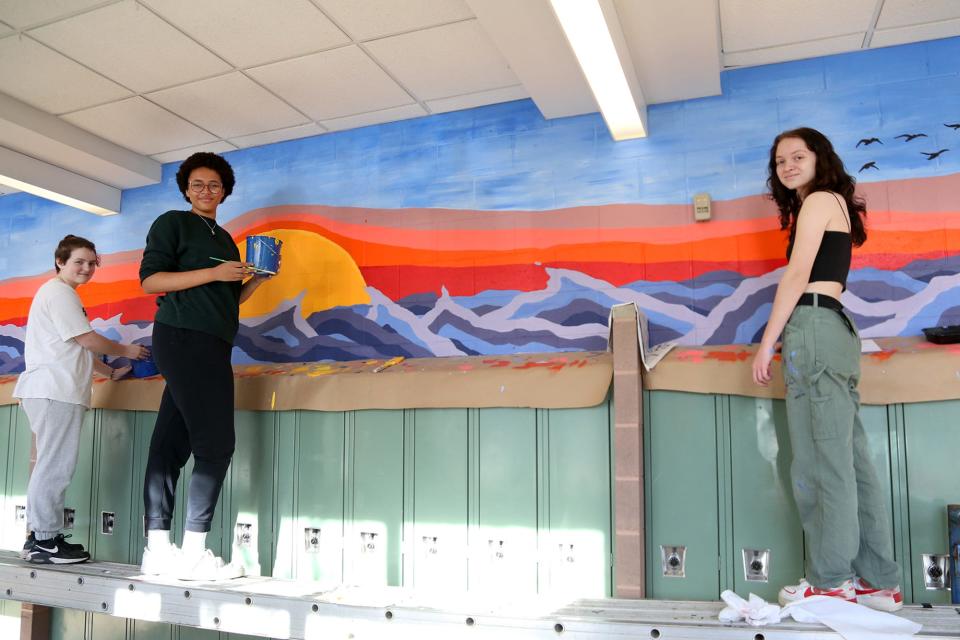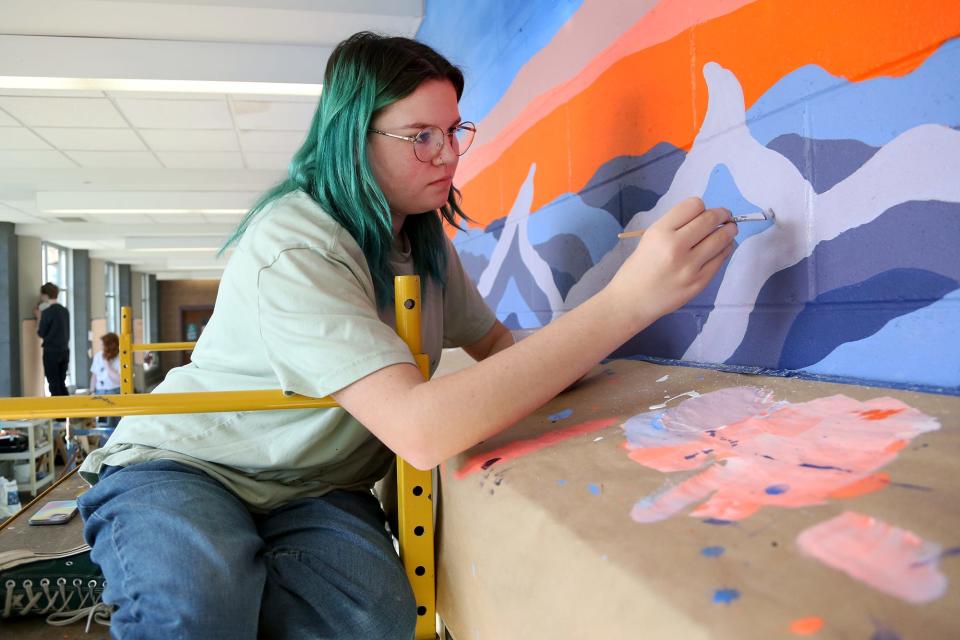Traip mural honors school's land stewarded by Native Americans through 'power of art'
KITTERY, Maine — Members of Traip Academy’s civil rights team spent months of the previous school year researching and developing a land acknowledgment statement, honoring the public high school’s location on land stewarded in the past and present by Native Americans.
Now the effort has become an ongoing schoolwide project, most recently exemplified by a spectacular mural slated to be officially unveiled Monday afternoon, Nov. 21, at the school.
The 85-foot-long painting depicts a brilliantly colored orange-tinted sunrise peeking over the crashing surf of the Atlantic Ocean, and stretches down a hallway of lockers near the school’s main entrance. The scene reflects the legacy of the Wabanaki Confederacy, which translates to “People of the First Light" or “Dawnland.”

“It just brings awareness to the power of art,” Traip’s visual arts teacher Kim Lightcastle said. “It’s the start of a lot of work we need to do.”
And this is a point both Lightcastle and the school’s civil rights team adviser Erika Vargas emphasize. As remarkable as the mural may have turned out, it is not the culmination of a project but rather another step in the process.
“Land acknowledgments are meaningless without action,” Vargas said.
How Traip's land acknowledgment project started
This particular effort kicked off roughly a year ago, when members of Traip’s civil rights team decided to create a land acknowledgment statement, a Native American tradition of honoring and recognizing the land, and our connection to it. The idea generated from conversations during Native American Heritage Month in November 2021, Vargas said.
The civil rights team is one of many across the state, part of a program under the Maine attorney general’s office.
As part of their research and education, students watched the Emmy Award-winning 2018 documentary “Dawnland.” The film explores the intentional 20th century effort to erase the culture of Maine’s Wabanaki people by removing children from their homes and placing them with white families, in order to assimilate them into white society.

The students utilized a previous South Berwick Public Library land acknowledgment as a template for their own document. They incorporated some Abenaki wording, a dialect of the Algonquian language, into the statement honoring the Abenaki, Pennacook and Wabanaki people. They acknowledged that their school is located on land known as “N’dakinna,” the traditional ancestral homeland of these Native Americans, and honored the stewardship of the Indigenous community “for more than 12,000 years.”
Lightcastle noted that the process of information gathering has been as important for the students as the finished project. The students reached out to various Indigenous leaders in the area when putting their statement together, and learned Native Americans remain a vital part of the modern community.
Lightcastle and Vargas co-advise the team, and are both Kittery school parents as well.
“It addresses that there is a continuity of Indigenous presence and culture in the past, present and into the future,” they declared in an announcement of Monday’s unveiling. But really, the statement was just the beginning.
1930s rescue boat lands at Wood Island:'Emotional' maritime history revival in Kittery
How the vision for the mural developed at Traip
Art students watched the morning sunrise together from Kittery’s Seapoint Beach, and collaborated with the civil rights team to create a visual representation of the land acknowledgment. The mural they completed is based on the morning view from Seapoint.
Local artist Julia O’Connell painted alongside the students throughout the two days in October it took to complete the mural, and provided “much positive support for this project,” Lightcastle said. Other community members lent their talents to the cause as well. Resident Mike Thompson brought his own scaffolding to the school, set it up so students could paint their mural, and then packed it up to take home when they were done.
The school’s language department and foreign exchange students translated the document into other languages, and these interpretations have been painted onto columns along the wall opposite from the mural. The publications department helped with documentation. Brandon Farmer of the Traip publications and history department put together a two-and-a-half minute video of the mural going up. The history department is expected to discuss Maine’s Indigenous cultures in the classroom this spring.
The Wabanaki Confederacy of Native Americans so prominent in Maine includes four different Eastern Algonquian tribes - the Passamaquoddy, Penobscot, Maliseet and Micmac. Students utilized in their research such resources as Wabanaki Reach at www.wabanakireach.org, and the Indigenous New Hampshire Collaborative Collective at www.indigenousnh.com, according to Vargas.
The meaning of the ceremony at Traip
Monday’s ceremony is slated to open with student speakers explaining how land acknowledgment must be accompanied by action, “which in the school's case means furthering District-wide education on Indigenous People, past, present and into the future,” Vargas said.
Then Paul and Denise Pouliot, head speakers of the Cowasuck band of the Pennacook Abenaki People, will offer closing statements at the community unveiling. The event is slated to start at 2:15 p.m. and is open to the public.
While the event is taking place just a few days prior to Thanksgiving, Lightcastle and Vargas both pointed out the unveiling should not be considered a celebration of this particular holiday.
“For many Native Americans, Thanksgiving is a time of mourning,” Vargas said, noting the day actually serves as a reminder of the genocide perpetuated against their people.
Traip Principal John Drisko, who is retiring after the current school year, said this week the acknowledgment statement and mural recognize “the careful stewardship by the Wabanaki people for over 12,000 years, of the land we live on and enjoy today.”
He also expressed gratitude to the civil rights team, which “spearheaded, designed, and completed” the project.
“The light of the mural will inspire students for generations to come to understand the importance of the Wabanaki in their lives today,” Drisko said.
Kittery's 375th: 'The perils of everyday life': When the town was a constant battleground
Traip Academy land acknowledgment statement
At the mouth of Peskategwa, R.W. Traip Academy is located on N’dakinna, which is the traditional ancestral homeland of the Abenaki, Pennacook and Wabanaki peoples past and present. We acknowledge and honor with gratitude the land and waterways and the aln8bak [all-nawm-bock] (human beings) who have stewarded N’dakinna throughout the generations, affirming that there are Native people in Maine and the wider Wabanaki homeland today and that their story has continued for more than 12,000 years.
This article originally appeared on Portsmouth Herald: Traip mural honors Native American stewards of school land Kittery ME

